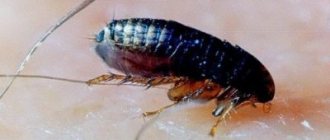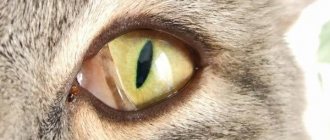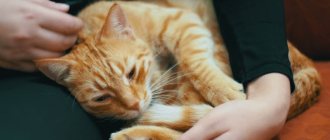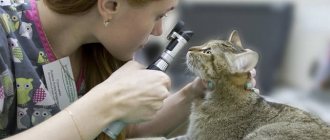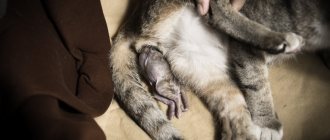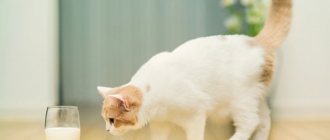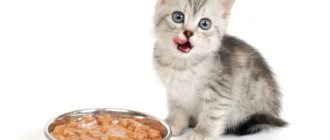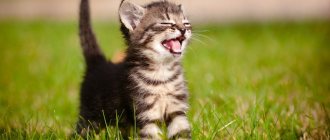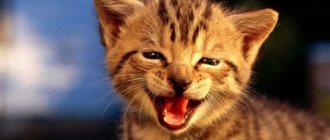When does a cat produce milk?
Typically, cats produce milk immediately after their babies are born.
At this time, the animal’s body releases the hormone oxytocin, which stimulates lactation. Also, a few days before the onset of labor, the first drops of colostrum may be released from the nipples. For various reasons, milk production may begin only 2-3 hours after all kittens are born.
Babies instinctively find the nipples and begin to stimulate them, which allows milk to flow into the mammary glands.
Colostrum
Shortly before birth, colostrum begins to be released - a sticky straw-colored liquid containing antibodies, with which the kittens are transmitted resistance to various viruses, developed by the mother's immunity.
It is very important that babies receive colostrum in the first day of their life; later their intestinal wall will become impenetrable to maternal antibodies. Colostrum cannot be replaced by anything (antibodies from the mother cat are unique), and it begins to be released 1-2 days before birth. You can check this by gently massaging and squeezing the area around the nipple.
First pregnancy
Caring for a pregnant cat can seem like a daunting process, especially if you have no experience with it. In fact, in most cases, pregnancy in a cat occurs naturally and often unnoticed by the owner.
Naturally, if the pregnancy is planned, the health of the expectant mother should be monitored by a veterinarian. In addition, before the planned mating, both parents must receive worm prevention and a full range of vaccinations. If you are not sure that you are ready for the birth of kittens, your cat has no breeding value, and mating is not controlled by the breed club, it is better not to allow your pet to become pregnant.
If your pet is outbred, it is more reasonable to sterilize her before going into heat. Spaying a cat after the first birth is also acceptable, but:
- You will have kittens for whose fate you are responsible.
- Your pet will have to endure the stress associated with pregnancy and childbirth.
- The cat's body will undergo a long process of hormonal balancing.
- After giving birth, the cat will be weakened and may have a harder time withstanding sterilization.
- An old cat (and a young one too) may experience complications during and after birth.
It happens that cat owners become hostages of the situation, that is, they find out about their pet’s pregnancy after the fact. Many owners think that a cat’s small age is an obstacle to bearing offspring. However, be vigilant, as mongrel cats can go into heat at the age of five to six months. Such a young body is not ready for the stress associated with pregnancy, and this is fraught with problems during pregnancy.
The optimal period for bearing kittens is considered to be no younger than 1–1.5 years. After pregnancy and until the end of the feeding period, the cat does not enter into sexual heat and needs special care.
As soon as you find out that your pet is pregnant, you need to take her to the veterinarian. If the pregnancy is not planned, but the term is early, most likely you will have time to prevent parasites that can threaten kittens during development and after birth. After the examination, the doctor will be able to determine the approximate duration of pregnancy.
During the consultation, you will receive recommendations on nutrition and care for your cat. A reasonable approach to diet planning and following your doctor’s recommendations is one of the most reliable ways to avoid weight gain and complications during childbirth.
Normally, the pregnancy of a cat that was fertilized during a favorable period lasts 63–68 days. Due to individual characteristics and some external factors, labor may occur from 61 to 70 days. A slight delay in pregnancy is not a reason to panic, but the condition of the expectant mother needs to be closely monitored.
In the early stages of pregnancy, the expectant mother does not need special care. You may notice that your cat prefers to be in a quiet environment, sleep more and pay less attention to communication. Metamorphoses regarding behavior, be it excessive affection or a sharply manifested absurd character, are considered the result of hormonal surges.
Make sure, regardless of the stage of pregnancy, that your cat does not gain excess weight. In the first month, the pet must be encouraged to play and be physically active. In the second trimester, when it becomes difficult for the cat to move, weight control is carried out through diet and fractional meals.
Before giving birth, you may notice that your cat is not taking good care of itself. This can happen if the pet’s belly has become too large and it is difficult for her to curl up for licking. For long-haired cats, it is recommended to carefully trim the hair in the genital area. If necessary, the anal area is cleaned regularly using wet wipes.
Why might this happen?
In general, there is no need to immediately suspect any pathology. There are also more prosaic explanations. In particular, primiparous cats may show anxiety. They just don't know what to do. A young mother may simply get tired if the kittens constantly squeak and do not allow her to leave to eat or go to the litter box. This problem is quite simple to solve. It is enough to buy an electric infrared heating pad in the form of a thin mat and lay it on the floor of the basket/box with kittens. Of course, the entire structure must be carefully covered. The algorithm of actions is simple - as soon as the cat goes about its business, turn on the heating pad. Kittens will sleep while warm, and therefore your pet will have more time.
As for the anxiety of a first-time cat, try to talk to your pet more often, trying to calm her down. Gradually, the animal will get used to the newfound kittens, and therefore will become much calmer. The main thing is not to worry yourself, as your pet, sensing the owner’s nervousness, will panic even more. This will not lead to anything good. Consult your veterinarian: today there are many mild sedatives that are perfect for such cases.
In particular, you can use products designed to calm animals during transportation. We advise you not to overdo it with the dosage: if you give your cat too much medicine and it becomes “stunned,” then the pet will not be able to properly care for the kittens. Or he will simply fall asleep, leaving them to their fate.
How to tell if a cat doesn't have milk
The main sign of a well-fed kitten is silence. If babies sleep peacefully and wake up only to eat a hearty meal, it means that the mother is producing enough milk, and the owner does not need to worry.
If the kittens are restless, constantly squeak, crawl around the box or maternity box and often suck on the nipples, this indicates that they are hungry. These babies have sunken tummies and grow slowly. Many owners wonder: what to do if the cat does not have milk, and how to help her.
Psychological problem
Childbirth causes stress in a cat, which changes its behavior. Usually this happens in inexperienced, young animals who do not know how to behave correctly. Any squeak from the cub provokes anxiety. A cat may also be restless after giving birth due to problems with lactation. She realizes that her cubs are not getting enough to eat, so she worries and calls for help. Owners must find out the cause of the alarm and then take immediate action. You should dilute the mixture for kittens and try to feed them. Well-fed cubs will not squeak or agitate the animal.
Sometimes people themselves cause the cat to become anxious. This happens when they become overly curious about her newly born cubs. This kind of human behavior worries the mother cat. She may begin to move the kittens around, hiding them from prying eyes. There is no point in causing unnecessary stress to animals in this way. Provide your cat with maximum comfort and silence.
Signs of labor in a cat
Almost the entire pregnancy of a cat will proceed without any special changes, provided that the pet does not have any difficulties with bearing offspring. The birth of a primiparous cat may be a surprise, but an attentive owner will notice behavioral changes that become apparent 1-2 weeks before the kittens arrive.
During the period when a cat is preparing for the birth of kittens, her character changes. How exactly your pet’s character will change is unknown. Some cats become more affectionate, while others become withdrawn. Many owners say that during pregnancy their pets changed beyond recognition. Moreover, some cats remained calm until the birth, others showed obvious behavioral changes several weeks before the actual birth of the kittens.
Against the backdrop of increased appetite, in the last few weeks of pregnancy, a few hours or even a day before giving birth, the cat begins to refuse food. About 2-3 hours before the kittens are born, the cat stops eating, but continues to drink. In addition to lack of appetite, restlessness and obvious discomfort (the cat cannot lie down) are considered to be warning signs of labor.
The young mother's body begins to produce milk. With the onset of lactation, the cat's mammary glands become denser and increase in size. When palpated, you may notice a discharge of clear or creamy liquid. These secretions do not look like milk, since at first (1-3 days) the cat feeds the offspring with colostrum.
We suggest you read: Which cats are better at catching mice and rats, cats or cats?
All cats go through stages of nest building. The timing can vary from 2 weeks to 2 hours before birth. The cat inhabits the bottom shelf of the closet with clothes, the space under the bed or another secluded corner. To make caring for kittens easier, prepare a nest for her in advance and place it in a quiet place that is comfortable for the cat.
The first signs of labor that can be recorded are changes in body temperature. A cat's normal temperature ranges from 37.7 to 39.1 degrees. Before birth, the base temperature drops several degrees. Changes usually occur a day before birth.
No intervention is required on your part; the cat does not need to be warmed or take other measures. The drop in temperature does not affect the internal organs. It is not recommended to take temperature measurements too often, since irritation of the colon mucosa can cause spasms.
The process of giving birth to kittens is difficult to miss, since most cats begin to meow and become very anxious during contractions. Before childbirth, the so-called mucus plug comes out. If the cat goes to the litter box, you may not notice this stage. The mucus plug looks like a clot (transparent, whitish, greenish) that comes out with a small amount of liquid.
Possible reasons
It happens that after giving birth a cat becomes restless, meows, looks into the eyes, and fusses. Her unusual behavior is associated with:
- her or her cubs' physical condition;
- psychological reasons (depression or stress).
When the birth takes place without complications, the cat’s health is normal, then she calmly lies down with the kittens, providing the latter with access to the nipples. She may refuse food and water for some time. This is a normal condition, the cat is just afraid to leave helpless kittens.
When can discharge indicate pathology?
There are several reasons why a mother cat does not produce milk:
- Retention of the placenta after the end of labor. In order for it to come out, the animal is given an injection of oxytocin or calcium borogluconate. These drugs stimulate contraction of the uterus, causing the placenta to be expelled. If this does not happen, veterinarians perform surgery.
- Pyometra or endometritis. After giving birth, a cat's uterus may become inflamed, with pus accumulating in its cavity. This happens for two reasons: a greatly distended uterus or the afterbirth remaining in it. Pyometra can be recognized by the cat's behavior: it becomes restless, breathes heavily, hides in dark corners, and white discharge appears from the noose. Pyometra is treated with antibiotics (at an early stage) or surgery if the disease is already very advanced.
- Eclampsia. This condition is caused by an acute calcium deficiency in the animal’s body. Eclampsia develops during the first two days after birth. The cat experiences convulsions, and without help it may die suddenly.
- Mastitis. With this disease, the cat's mammary glands become inflamed. They become hard and hot and milk is not produced. The animal experiences first discomfort and then severe pain in the chest area.
- Stress. Cats giving birth for the first time can be very nervous and even aggressive. They do not understand what happened to them, they worry, they may leave the babies and refuse to feed them. This happens because the hormone oxytocin is not produced immediately, and therefore milk does not yet begin to flow into the mammary glands.
- Lack of maternal instinct. Some cats can abandon their offspring immediately after they are born. The milk production process does not start in a timely manner, and the animal refuses to be near the babies. You can try to awaken the maternal instinct in your pet. To do this, the kittens need to be placed close to the nipples, and the cat must be carefully held and calmed.
- Incorrect cat diet before and during birth. A cat may not produce milk if she does not get enough nutrients from her food. It is very important to correctly prepare the diet of a nursing animal and prepare milk mixtures.
In cases where the discharge has an unpleasant odor, or you notice impurities in it, or in situations where something else bothers you, be sure to consult a veterinarian. We remind you once again that in the first days after childbirth, vaginal discharge may contain quite significant amounts of blood, but there is nothing to worry about.
In addition, in normal cases of postpartum involution of the uterus, not accompanied by any inflammatory processes, the animal’s external genitalia should not be swollen or painful. If such signs exist, then they clearly indicate some kind of pathology. What to do? Of course, contact a specialist.
You should also do this in the following cases:
- Suspicion of ruptures of genital tissue (if the birth was difficult and protracted).
- The discharge is brownish in color, but it is too thin and has a disgusting odor. Such symptoms may well indicate necrotic endometritis.
- You should always contact a veterinarian if dead kittens were noticed during childbirth, or if you suspect that the cat did not “give birth” to all the placenta.
In all the situations described above, the health of both the cat and all its offspring is in danger. It consists of sepsis - a common consequence of severe forms of endometritis. Toxins that enter the bloodstream can cause the death of the cat herself, and kittens that feed on her milk will definitely not become healthier.
In addition, the appearance of pathological discharge immediately after childbirth may indicate, for example, that the mother has chlamydia. In such cases, the kittens themselves may well have hidden pathologies of internal organs, which will certainly appear later. Not to mention the fact that the cat owner himself may well become infected with chlamydia (if he has not already become infected).
First aid for newborns
Among domestic cats, stillbirth is not uncommon. Even under satisfactory housing conditions, the percentage of stillborn kittens ranges from 4 to 15%.
Very often, the reason why a cat’s kittens die is the inexperience and illiteracy of the animal owner. Often, newly born babies may seem lifeless. Newborns may not move or make any sounds and are often mistaken for stillborn. However, competently carried out resuscitation measures can save the baby’s life:
- First of all, it is necessary to free the kitten from the shell, this will allow him to breathe on his own.
- The umbilical cord should be pinched with your fingers at a distance of 2 cm from the tummy for a few seconds (squeezing the blood vessels) and cut with sterile scissors. The wound should be treated with an antiseptic.
Scissors, gauze pads and antiseptic are the necessary materials for giving birth to a cat.
- Your baby's nose and mouth may become clogged with mucus. In this case, it is necessary to empty the oral cavity and nasal passage using a small syringe.
Diapers and a syringe are important tools
- After this manipulation, the cub is wrapped in a waffle towel and tilted head down to remove the remaining mucus.
- Mouth-to-mouth artificial respiration helps to revive weak kittens. This should be done with the help of devices: a straw, a small syringe, etc. You need to blow air into the mouth at intervals of 3 - 5 seconds in small portions, taking into account the size of his lungs.
- Carefully licking her kittens, the mother cat, at the level of instinct, carries out resuscitation of the weak cub. The owner can also imitate this behavior by using fingers wrapped in a sterile cloth for massage. Massage movements should be carried out on the head (from the forehead to the back), along the torso (from the tail to the neck) and on the tummy (in circular movements from the chest to the perineum). Manipulations should be carried out intensively.
- At home, ammonia has been successfully used to revive kittens. A cotton wool soaked in the preparation should be brought to the baby’s nose several times.
You should know that resuscitation measures can be carried out for no more than 5 - 7 minutes if there is no heartbeat, and no more than 20 minutes if there is a heart rhythm.
We recommend reading the article about when you can sterilize a cat. From it you will learn about the best age to sterilize a cat and about periods in an animal’s life when sterilization should be delayed.
Childbirth - stages and nuances
Labor begins 2–24 hours after the mucus plug is released. The first stage of labor begins with contractions. The duration of the first stage depends on the individual characteristics of the woman in labor. If a cat gives birth for the first time, contractions can last up to 12 hours. A few hours before the kittens are born, contractions of the peritoneum are visible visually.
The birth of the first kitten is the most labor-intensive process, since the baby expands the birth canal. Normally, a kitten is born head first. Immediately after the bubble appears, the cat breaks it and actively licks the baby. The kitten instinctively moves towards its mother's nipples, guided by the smell. While the baby is sucking milk, the cat actively licks the genital area, which stimulates further attempts.
We invite you to read: Grain-free cat food: advantages and disadvantages
After the birth of the kitten, the cat makes another attempt, with which the afterbirth comes out. If you do not interfere with the birth process, the cat will eat the afterbirth. There are controversial opinions about eating afterbirth. The problem is that eating the placenta allows the cat to regain electrolyte balance and strength. In the wild, cats give birth to no more than 2–4 kittens. In a domestic cat, the number of kittens in a litter can reach 8–10. If a cat eats all the placenta (6–10 pieces), it may develop severe diarrhea.
What to do if your cat has little or no milk
If a mother cat does not have milk, first of all you should make sure that she does not have any pathologies. The box with the offspring and pet is placed in a quiet and dark place. The cat should not be nervous or stressed.
If the animal does not have enough milk, breeders recommend using the following recipes:
- Nettle inflorescences. They are first collected, washed and dried. The inflorescences are then ground with a coffee grinder into flour and added to the animal’s food.
- Wild raspberry leaves. A decoction is prepared from them, which is given to the mother cat, 15 ml three times a day.
- Walnuts, sour cream and milk. Nuts (10 pcs.) are crushed, poured with boiling milk (500 ml) and left to infuse for 3-4 hours. After this, the mixture is filtered. After the infusion becomes warm, add a couple of tablespoons of thick sour cream. The mixture is mixed well, wrapped in a blanket and left for a day to ferment. This yogurt is fed to the animal.
- Carrots and sour cream. The fresh vegetable is grated on a fine grater or ground using a blender and mixed with sour cream.
- Quail eggs. Egg shells are washed and dried well. It is then ground to a powder using a coffee grinder. The resulting mixture is combined with thick village sour cream and given to the cat.
- Cream, eggs and glucose. One quail egg is mixed with 20 ml of cream 10% and 5 ml of glucose 5%. This mixture is given to the cat every day immediately after the kittens are born for a week, then it is fed every 3-4 days.
Lactation is well stimulated by drinking plenty of fluids, a calm environment and adequate, balanced feeding. You can also offer your pet infusions and decoctions of herbs: nettle, dandelion, anise, cumin, catnip, fennel.
Many breeders recommend giving a nursing cat warm black, weak tea with a small amount of condensed milk. You can also switch your pet to a special diet designed for feeding lactating animals: Royal Canin BABYCAT, 1st Choice Kitten CHATON, etc.
Complications during childbirth and the postpartum period
Let's look at the symptom of what complication postpartum bleeding can be. Let's start with the reason mentioned above - incomplete expulsion of kittens or placenta.
Many inexperienced owners believe that the end of pushing indicates the completion of the birth process. However, if the cat was not examined by ultrasound during the last stage of pregnancy, the owner cannot know the exact number of kittens that were due to be born. In this case, there is a risk that a dead kitten or the placenta of the last born cub will remain in the uterine cavity.
With such complications, the first alarming symptoms appear within 24-72 hours after birth.
- The cat's appetite rapidly deteriorates, apathy appears, and as a result of painful sensations, the young mother abandons the kittens.
- Brown discharge with a small amount of coagulated blood appears from the cat's vagina.
- As complications develop, baseline body temperature constantly rises.
- When you palpate your cat's abdomen, you will find that the abdominal muscles are tense and she is reacting to pain.
If symptoms are detected in time and correctly interpreted, conservative treatment is used to resolve the situation. After stimulating additional pushing and cleaning the uterine cavity, the woman in labor is prescribed a course of broad-spectrum antibiotics to prevent the development of a bacterial infection. If more than a day has passed since the birth, the veterinarian will have to perform castration - remove the uterus.
The second common complication is metritis or inflammation of the uterus. The complication can develop within 3 days after the completion of labor. When metritis develops, the cat looks depressed and clearly sick. When measuring the temperature, it will be found that it is elevated. From the first day of the development of the malaise, the young mother refuses to eat, abandons the kittens and ignores drinking, which quickly leads to dehydration.
With metritis, bloody discharge from the genital tract has a characteristic unpleasant odor. Quite often there is pus in the blood. When you feel the belly of a young mother, you will feel that the abdominal wall is tense. Despite severe pain and muscle tone, an enlarged uterus is felt upon palpation.
Metritis develops against the background of rapid proliferation of pathogenic bacteria. The condition is alleviated by a course of antibiotics, but treatment may not be effective if the spectrum of the drug is chosen incorrectly. Positive dynamics should appear on the first day after the start of treatment. If no positive dynamics are observed after 24–48 hours, the only way to save the cat is through surgery followed by removal of the uterus.
A less common, but no less dangerous complication is uterine prolapse. Typically, such complications result from a difficult birth. In human terms, during childbirth, the cat literally pushes out or inverts the uterus, which leads to protrusion from the birth canal and severe bleeding.
With prolapse, the clinical picture develops very quickly, and the symptoms are very similar to rupture of the uterine walls. In both cases, severe bleeding is observed, which must be stopped as soon as possible. Further treatment is carried out with the help of surgery, as a result of which the uterus will be removed and its stump will be reduced.
The most dangerous complication after giving birth to a cat is perforation of the uterus or rupture of its walls. Such a violation does not occur without a reason; usually the cat has problems during pregnancy. Prolonged labor, when the cat is in contractions for more than 12 hours or pushing for more than 2 hours, can also cause rupture of the walls of the uterus.
Ruptures in the walls of the birth canal are often caused by manipulations performed by the owner or veterinarian when the kitten gets stuck during expulsion. To remove a stuck kitten from the birth canal, it is necessary to use lubricants, at least Vaseline oil. The kitten is pulled up only during pushing! Forced or abrupt removal of the kitten from the birth canal is guaranteed to lead to overstretching or rupture.
We invite you to read: Detailed description of the African Serval cat breed
Uterine rupture can occur if the owner tries to pull the failed placenta by the umbilical cord. Such manipulations are strictly prohibited and are not carried out by veterinarians. Medications are used to stimulate expulsion of the placenta.
Labor stimulants can actually cause harm if used inappropriately or in the wrong dose. However, their use is safer than forcibly removing the placenta from the uterine cavity.
After the cat bursts the bubble, it begins to actively lick the kitten, which stimulates its respiratory activity. Normally, newborn kittens squeak and move actively. A cat may give birth to still kittens. The chances of salvation depend on the reasons for which the complications occurred. Most often, a kitten does not breathe after birth for the following reasons:
- The cat does not lick the kitten - in order for the lungs to open, it is necessary to remove mucus from the nose and mouth. By licking, the cat actively stimulates blood circulation. If the mother does not show interest in the kitten, you will have to perform resuscitation.
- Prolonged labor - the kitten may die if it remains in the birth canal for a long time. Regardless of the duration of the effort, the death of a kitten is considered clinical, that is, it needs to be assisted.
- The death of a kitten in the womb - in this case, the liquid in the bladder has a pungent odor, and the kitten is born cold with inactive limbs. In this case, no help is provided, since the kitten is already brain dead.
Most cats carry kittens and give birth without difficulty. However, some complications can occur both immediately after birth and throughout the entire period of breastfeeding.
Lack of milk is a common problem in cats that have given birth for the first time. Most often, disorders are caused by an unbalanced diet, vitamin deficiency or dehydration. The following signs may indicate a lack of milk:
- Kittens do not gain weight, behave restlessly, squeak for a long time and loudly.
- The cat gets nervous and leaves the nest.
- The cat eats a lot, but does not gain weight at all.
What to do if there is not enough milk? Depending on the condition of the cat, there are two options: supplement the kittens with a milk replacer or completely transfer the babies to artificial feeding. The cat's diet must be balanced and enriched with calcium products. It is important to make sure that your pet is not dehydrated. When lactation normalizes, artificial feeding can be stopped.
Galactostasis (lactostasis) is a common disorder in primiparous cats and in small pregnancies. The condition is caused by swelling and inflammation of one or more mammary glands, due to stagnation of milk. The following signs indicate the development of galactostasis:
- The cat is restless while feeding.
- One or more breasts become hard and tender.
- The pet's condition is alleviated if the nipple is warmed and massaged so that the stagnant milk comes out.
Mastitis is characterized by:
- Severe swelling of the affected mammary glands.
- Acute pain and a noticeable increase in body temperature (locally at the beginning, then general).
- The cat begins to avoid the kittens and does not feed them.
- The cat experiences apathy and a sharp decrease in appetite.
During the early stages of mastitis, the cat continues to feed her kittens. In most cases, kittens become infected with a bacterial infection, which results in lethargy, stunted growth and increased body temperature. If the situation is ignored, the kittens die, and the cat develops purulent mastitis.
Postpartum eclampsia is an insidious complication that is observed in primiparous cats. Eclampsia is often called milk fever because the cat rapidly loses calcium, resulting in hypocalcemia. Symptoms of eclampsia:
- Fever.
- Lack of appetite.
- Severe anxiety.
- Frequent and heavy breathing.
If eclampsia is ignored, the condition becomes severely and quickly complicated. The cat lies down and does not respond to the name, at the same time you can observe:
- Pallor and cyanosis of the mucous membranes.
- Profuse salivation.
- Cramps, spasms.
- Disorders of the central nervous system - loss of balance, lack of coordination of movements.
Eclampsia is an acute, deadly condition that will kill a cat within a few hours. The condition is treated with calcium supplements and general supportive therapy. During treatment, kittens are removed from their mother and transferred to artificial feeding.
Metritis is another insidious complication caused by incomplete expulsion of embryos or placenta from the uterus. During the first birth, the cat may not have enough strength, which will lead to the cessation of contractions and pushing. The cervix closes, although the embryo or afterbirth remains in the cavity. Literally within a day, inflammation develops, which is accompanied by the following symptoms:
- Fever.
- Loss of appetite.
- Ignoring kittens.
- Lethargy and apathy.
- Vaginal discharge that has a strong odor or is green in color.
The condition is relieved by stimulation of labor, and if more than a day has passed, by surgery. A cat is guaranteed to die if the symptoms of metritis are ignored!
Nutritional Features
Feeding is the most important process in the first weeks of a baby's life. When the kittens are near the cat, they can at any time cling to the food source, but in its absence, you will have to provide the kitten with regular food - every 1-2 hours. In the first week of life, kittens eat little - a couple of spoons of milk, but often, so such a time interval is necessary.
Feeding a kitten with a syringe
It is important to know! Cow's milk is strictly prohibited for kittens in the first months of life - it can cause diarrhea, which prevents the entry of useful and nutrients into the body, which can lead to the death of the babies.
Milk substitutes
It is recommended to feed newborn kittens with a cat's milk replacer. It is designed specifically for kittens, so its composition is balanced specifically for the growing cat’s body. It is believed that cat's milk is much more nutritious than cow's milk, therefore all the microelements and vitamins that kittens need at this age stage are added to the milk substitute purchased at a specialized pet store or veterinary pharmacy.
A special syringe for feeding kittens is often included with the milk replacer.
The packaging with the substitute always contains cooking instructions and a table indicating the ratio of the age or weight of the kittens and the dosage for one meal. All you need for feeding is a bottle and a nipple, which, as a rule, are included in the package with a milk replacer. If you don’t have these tools, you can always buy them in the same place as baby food or replace them with a pipette and a syringe without a needle. Sometimes the instructions for the substitute indicate that it is necessary to prepare it with bottled low-mineralized water, but if necessary, it can be replaced with filtered or settled boiled water.
You can read more about syringe feeding kittens below.
Feeding kittens with a syringe
It is important to know! The food temperature for newborn kittens should be between 36-38°C.
How to feed kittens correctly?
Kittens, like human babies, need to be fed in an upright position to avoid injury. You need to press lightly on the bottle, but under no circumstances pour the milk mixture into the kitten - he must suck the “milk” himself. You can tell if the baby is full by his behavior: a hungry cat will squeak and crawl in search of his mother, and a well-fed cat will peacefully fall asleep.
It is important to know! If it is not possible to feed kittens with a special milk substitute for kittens, you can dilute it with formula for children under two weeks of age, but provided that the consistency is 2 times thinner than indicated in the instructions for the infant formula.
An example of a milk replacer for kittens
Even if kittens live with a nursing mother, at the age of 3-4 weeks they should be introduced to complementary foods:
- low-fat cottage cheese;
- milk porridge;
- scraped meat;
- special delicate pates and mousses for kittens;
- dry food granules for kittens soaked in milk.
The amount of complementary foods should start with no more than 5-15 g and gradually increase. Complementary foods should be given before the main meal.
